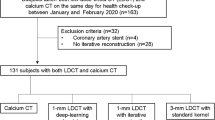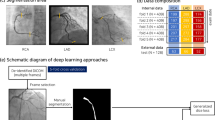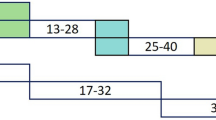Abstract
To explore the diagnostic value of deep learning algorithm in coronary arteries in children with Kawasaki disease, convolutional neural network (CNN) was applied in the segmentation of dual-source computed tomography (CT) (DSCT) image information of coronary artery lesions in children with Kawasaki disease. A CNN algorithm was improved, and the range image U-net (RIU-Net) was adopted to segment the CT image for convolution feature extraction. The improved model was fused with squeeze and excitation module and pyramid pooling to fabricate a new network (RISEU-Net), in which the ability of image features extraction was enhanced. Ninety children with coronary artery lesion of Kawasaki disease were selected and rolled into a control group (n = 45) and observation group (n = 45). The constructed model was used to segment the CT images of the two groups of patients, and the accuracy, sensitivity, and Dice of image segmentation were compared. The results showed that the utilization of key image features was improved after the SE module and pyramid pooling were integrated on the RIU-Net network. The lowest LOSS value of the RISEU-Net network was stable at about 0.02, and the effect was very fast during the training process. The sensitivity and accuracy of the constructed model to image detection were 95.6% and 96.7%, respectively. The negative predictive rate was 97.3%, and the positive predictive rate of 92.7%, which were all higher than those in the control group. The Dice values of RISEU-Net-N, RISEU-Net, and RIU-Net were 0.7765, 0.8562, and 0.8356, respectively. In summary, the RIU-Net network model proposed showed reliable feasibility and effectiveness for DSCT image segmentation, which effectively improved the clinical information evaluation of CT images of coronary artery lesions in children with Kawasaki disease, showing crucial reference for the development of intelligent medical equipment.











Similar content being viewed by others
References
Ghimire LV, Chou FS, Mahotra NB, Sharma SP (2019) An update on the epidemiology, length of stay, and cost of Kawasaki disease hospitalisation in the United States. Cardiol Young 29(6):828–832. https://doi.org/10.1017/S1047951119000982
Kourtidou S, Slee AE, Bruce ME, Wren H, Mangione-Smith RM, Portman MA (2018) Kawasaki disease substantially impacts health-related quality of life. J Pediatr 193:155-163.e5. https://doi.org/10.1016/j.jpeds.2017.09.070
Dusad S, Singhal M, Pilania RK, Suri D, Singh S (2020) CT coronary angiography studies after a mean follow-up of 3.8 years in children with Kawasaki disease and spontaneous defervescence. Front Pediatr 8:274. https://doi.org/10.3389/fped.2020.00274
Kantarcı M, Güven E, Ceviz N, Oğul H, Sade R (2019) Vascular imaging findings with high-pitch low-dose dual-source CT in atypical Kawasaki disease. Diagn Interv Radiol 25(1):50–54. https://doi.org/10.5152/dir.2018.18092
Chakraborty R, Singhal M, Pandiarajan V, Sharma A, Pilania RK, Singh S (2021) Coronary arterial abnormalities detected in children over 10 years following initial Kawasaki disease using cardiac computed tomography. Cardiol Young 28:1–5. https://doi.org/10.1017/S1047951121000020
Secinaro A, Curione D, Mortensen KH, Santangelo TP, Ciancarella P, Napolitano C, Del Pasqua A, Taylor AM, Ciliberti P (2019) Dual-source computed tomography coronary artery imaging in children. Pediatr Radiol 49(13):1823–1839. https://doi.org/10.1007/s00247-019-04494-2
Dodge-Khatami J, Adebo DA (2021) Evaluation of complex congenital heart disease in infants using low dose cardiac computed tomography. Int J Cardiovasc Imaging 37(4):1455–1460. https://doi.org/10.1007/s10554-020-02118-7
Wisselink HJ, Pelgrim GJ, Rook M, Imkamp K, van Ooijen PMA, van den Berge M, de Bock GH, Vliegenthart R (2021) Ultra-low-dose CT combined with noise reduction techniques for quantification of emphysema in COPD patients: an intra-individual comparison study with standard-dose CT. Eur J Radiol 138:109646. https://doi.org/10.1016/j.ejrad.2021.109646
Oh E, Seo SW, Yoon YC, Kim DW, Kwon S, Yoon S (2017) Prediction of pathologic femoral fractures in patients with lung cancer using machine learning algorithms: comparison of computed tomography-based radiological features with clinical features versus without clinical features. J Orthop Surg (Hong Kong) 25(2):2309499017716243. https://doi.org/10.1177/2309499017716243
Kim JS, Arvind V, Oermann EK, Kaji D, Ranson W, Ukogu C, Hussain AK, Caridi J, Cho SK (2018) Predicting surgical complications in patients undergoing elective adult spinal deformity procedures using machine learning. Spine Deform 6(6):762–770. https://doi.org/10.1016/j.jspd.2018.03.003
Dawud AM, Yurtkan K, Oztoprak H (2020) Corrigendum to “application of deep learning in neuroradiology: brain haemorrhage classification using transfer learning.” Comput Intell Neurosci 28(2020):4705838. https://doi.org/10.1155/2020/4705838 (Erratum for: Comput Intell Neurosci. 2019 Jun 3; 2019: 4629859)
Ding Y, Sohn JH, Kawczynski MG, Trivedi H, Harnish R, Jenkins NW, Lituiev D, Copeland TP, Aboian MS, Mari Aparici C, Behr SC, Flavell RR, Huang SY, Zalocusky KA, Nardo L, Seo Y, Hawkins RA, Hernandez Pampaloni M, Hadley D, Franc BL (2019) A deep learning model to predict a diagnosis of Alzheimer disease by using 18F-FDG PET of the brain. Radiology 290(2):456–464. https://doi.org/10.1148/radiol.2018180958
Giordani L, Quaranta MG, Marchesi A, Straface E, Pietraforte D, Villani A, Malorni W, Del Principe D, Viora M (2011) Increased frequency of immunoglobulin (Ig)A-secreting cells following toll-like receptor (TLR)-9 engagement in patients with Kawasaki disease. Clin Exp Immunol 163(3):346–353. https://doi.org/10.1111/j.1365-2249.2010.04297.x
Cai J, Xing F, Batra A, Liu F, Walter GA, Vandenborne K, Yang L (2019) Texture analysis for muscular dystrophy classification in MRI with improved class activation mapping. Pattern Recognit 86:368–375. https://doi.org/10.1016/j.patcog.2018.08.012
Zhong Z, Kim Y, Zhou L, Plichta K, Allen B, Buatti J, Wu X (2018) 3D fully convolutional networks for co-segmentation of tumors on pet-CT images. Proc IEEE Int Symp Biomed Imaging 2018:228–231. https://doi.org/10.1109/ISBI.2018.8363561
McCrindle BW, Rowley AH, Newburger JW, Burns JC, Bolger AF, Gewitz M, Baker AL, Jackson MA, Takahashi M, Shah PB, Kobayashi T, Wu MH, Saji TT, Pahl E (2017) American heart association rheumatic fever, endocarditis, and Kawasaki disease committee of the council on cardiovascular disease in the young; council on cardiovascular and stroke nursing; council on cardiovascular surgery and anesthesia; and council on epidemiology and prevention. Diagnosis, treatment, and long-term management of Kawasaki disease: a scientific statement for health professionals from the American heart association. Circulation 135(17):e927–e999. https://doi.org/10.1161/CIR.0000000000000484 (Erratum. in: Circulation. 2019 Jul 30; 140(5): e181-e184)
Goo HW (2021) Quantitative evaluation of coronary artery visibility on CT angiography in Kawasaki disease: young vs old children. Int J Cardiovasc Imaging 37(3):1085–1092. https://doi.org/10.1007/s10554-020-02054-6
Duan J, Jiang H, Lu M (2020) Risk factors for coronary artery lesions in children with Kawasaki disease. Arch Argent Pediatr 118(5):327–331. https://doi.org/10.5546/aap.2020.eng.327
Matsuoka R, Furuno K, Nanishi E et al (2020) Delayed development of coronary artery aneurysm in patients with Kawasaki disease who were clinically responsive to immunoglobulin. J Pediatr 227:224-230.e3
Pereira S, Pinto A, Amorim J, Ribeiro A, Alves V, Silva CA (2019) Adaptive feature recombination and recalibration for semantic segmentation with fully convolutional networks. IEEE Trans Med Imaging 38(12):2914–2925. https://doi.org/10.1109/TMI.2019.2918096
Author information
Authors and Affiliations
Corresponding author
Additional information
Publisher's Note
Springer Nature remains neutral with regard to jurisdictional claims in published maps and institutional affiliations.
Rights and permissions
About this article
Cite this article
Luo, P., Li, J. Dual-source computed tomography image information under deep learning algorithm in evaluation of coronary artery lesion in children with Kawasaki disease. J Supercomput 78, 11265–11282 (2022). https://doi.org/10.1007/s11227-021-04077-9
Accepted:
Published:
Issue Date:
DOI: https://doi.org/10.1007/s11227-021-04077-9




